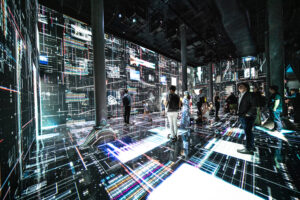Machine Hallucination: NYC is created by award-winning new media artist Refik Anadol for ARTECHOUSE in New York. Refik Anadol is a Turkish new media artist who creates dreamlike environments using machine intelligence. Anadol’s work experiments the intersection of humans and machines and he is considered a pioneer in the aesthetics of machine intelligence. He is a huge deal in this field so I’ve been waiting for a while now to see his work!
Machine Hallucination: NYC is an immersive environment that explores New York City’s past and potential future using pictures and other data available in public networks. Basically the algorithm learns about how the city’s silhouette changed over time and uses this data to predict how it may look like in the future. In addition, for the first time, a collection of 1000 unique immersive experiential NFTs are available for purchase only to on-site visitors of ARTECHOUSE’s New York location.
But this is more than algorithm-based architectural design; this is like stepping into the AI’s dreams. That’s why Refik Anadol refers to this artful end product as the “hallucinations of a machine”. It’s familiar because it’s the buildings we see around us everyday, but it’s foreign because they are somewhat distorted as the AI’s hallucinations are not quite like our reality; and it’s mesmerizing.
Machine Hallucination: NYC is not just a collaboration between Anadol and the AI; you are involved, as well. The data is pulled from public resources, which means we provide it by uploading pictures online. So if you’ve uploaded a photo of New York on the web, you were involved in deciding what the machine learns, or “dreams”. Congrats!
From a different angle, the machine is fed with our collective memory, and that’s why we are so similar. AI learns how things change and makes a prediction about the future. Don’t we do exactly the same? In that sense, Machine Hallucination: NYC provides food for philosophical thought which put me in the border of amazement and an existential crisis. It made me seriously consider whether we actually are in a simulation, because it made a lot of sense, but I’m not sure if this review is the right place for such discussion.

So, room for growth? The sound system. Visuals like this deserve an incredible sound design because sound creates at least the 50% of the space we are immersed in, however the experience doesn’t seem to use sound to amplify the awe. I’d imagine an impeccable sound system banging futuristic electronic music with classical melodies; molding past and future while reviving every cell in our body. Sound is not just sound; it’s frequency and vibration and it’s powerful! So as an immersive experience, I think not paying sound enough attention is somewhat a wasted opportunity to wow us the visitors even more.
Also, the experience reminded me how sharing the creative process matters. No matter what the artwork is, if you don’t tell us how you made it, we don’t necessarily get why it’s important or wow-worthy. I mean, almost everything looks cool when you project it on the walls, but it’s way cooler when you know where they come from. All the descriptions around the experience is poetic and philosophical, but they don’t explain much.
I can tell that there is the assumption that people who visit Refik Anadol’s exhibition already know that he uses artificial intelligence, but they could target a much larger audience if they make it a little more accessible. The phrases like “Of New York, by New York, for New York,” is like a politician’s statement whereas the experience itself is far from anything derivative or cheesy.
That’s why I would love to see behind the scenes footage somewhere in the exhibition like what the data looks like, how they chose which set of data to work with, how they played with the algorithm, if the code was rewritten because of an ugly-looking outcome, for instance. Anything that gives me more context about the work would compensate for the vague wording around the experience. I believe such a section would help the visiter appreciate the work more, and possibly more people to consider buying NFTs.
The NFTs are exclusive to ARTECHOUSE on-site visitors, which I believe is to prevent remote collectors from purchasing the NFTs as an investment in Refik Anadol and to ensure that the buyer “takes home” a piece of their real-life experience, possibly forming an emotional attachment between the collector and the digital artwork. The exclusivity seems to stem from some economic incentives for the artist and the venue while creating FOMO (fear or missing out) for the fans outside New York. Or I’m just speculating.
Machine Hallucination: NYC in ARTECHOUSE in Chelsea, which is a vibrant neighborhood filled with art galleries. ARTECHOUSE is like a next-generation art gallery, because it uses cutting-edge technology to immerse us in experimental arts. ARTECHOUSE, meaning the art and technology house, is a brilliant new kind of gallery that inspires artists to create using technology and to push limits. Visit ARTECHOUSE to see Refik Anadol’s work until January 17, 2022.
